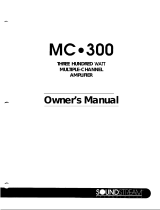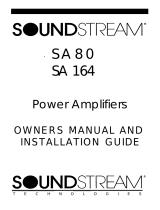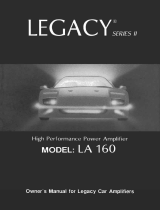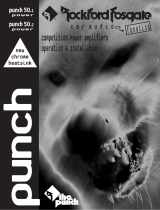Page is loading ...

D200 II
DUAL MONAURAL AMPLIFIER
CLASS A 100
PURE CLASS A AMPLIFIER
DlOO
II
STEREO AMPLIFIER
CLASS A 50
II
PURE CLASS A AMPLIFIER
D60
II
STEREO AMPLIFIER
Owner’s Manual

Soundstream Stereo
Amplifier
Owner’s Manual
Thank you for purchasing a Soundstream amplifier. You
now own one of the finest power amplifiers available,
a precision instrument capable of audiophile quality
performance.
To get the most out of your amplifier, we suggest that
you carefully acquaint yourself with their capabilities
and design. Please retain this manual for future refer-
ence.
Soundstream products are the result of American
craftsmanship and the highest quality control standards;
your power amplifier should deliver many years of pleas-
ure. Should it ever require service or replacement,
recording the information below will help protect your
investment.
Model Number
Serial Number
Dealer’s Name
Date of Purchase
Date of Installation
CONTENTS
paw
Design Features
..........................................................................................................
.2
Installation
....................................................................................................................
2
Location and Mounting
................................................................................................
.2
Selecting Operating Mode
..........................................................................................
.2
Optimizing for lmpedence
............................................................................................
2
Input Connections
........................................................................................................
3
Output Connections
.....................................................................................................
5
Power Connections
..........................................................................
............................
4
Remote Power-on connection
......................................................................................
4
Input Level Adjustments
..............................................................................................
.4
Linear Subwoofer Extension (LSE)
...............................................................................
4
Hookup Diagrams
........................................................................................................
5
lmpedence Hookup Diagrams
.....................................................................................
5
Specifications
..............................................................................................................
.6
1

INSTALLATION
The design topology of all Soundstream amplifiers utilize
multiple Darlington output devices with a total rated
output capability that far exceeds the potential output
of the amplifier. The D200 II utilizes 1000 watts of dis-
crete Darlington output devices while the
DlOO
II util-
izes 500, the Class A 100 1000, the Class A
5011
500
and the D60 II uses 300 watts worth of discrete
Dar-
lingtons. With such reserves and no current limiting,
these amplifiers operate without strain even at maxi-
mum output. Power, ground, and speaker connectors
are rated to handle up 80 Amps and up to 10 gauge
wire.
Unlike most car audio amplifiers, (some of which re-
quire a fan for cooling) which shut off when they over-
heat, all Soundstream amplifiers eliminate this prob-
lem in two ways. First, the Soundstream “Chassisink”
has been custom designed to guarantee the lowest
possible thermal resistance (maximum cooling)
,
greatly
reducing the possibility of overheating. Secondly, if this
should occur, all Soundstream amplifiers incorporate
our “Smart Power Supply” which simply reduces the
supply’s potential, allowing the amplifer to run much
cooler. The entire process is automatic and inaudible.
In the case of an actual amplifier malfunction, secon-
dary thermostats or fuses will shut down the amplifier
in a conventional manner. To prevent potentially
damaging turn-on and turn-off thumps, a pair of relays
at the outputs allow the amplifier to fully stabilize be-
fore sending the audio signal to the loudspeakers, except
on the D-60 which utilizes a built in delay circuit
.
An especially useful feature in the 0200 II and CLASS
A100 is the Linear Subwoofer Extension Circuit (LSE),
which compensates for the natural
rolloff
of most speak-
ers and extends bass as much as one full octave.
LSE,provides a linear boost of 6 dB/octave, starting at
a point which is continuously variable over the range
35280 Hz. A subsonic filter attenuates the signal be-
low 20 Hz.
Only premium parts are used in Soundstream amplif-
ers, such as metal film resistors, Glass epoxy circuit
boards with corrosion resistant masking, gold-plated
input connectors, and immersible sealed potentiome-
ters. The heat sink of all models doubles as the chas-
sis Each heat sink is custom designed and manufac-
tured to Soundstreams exacting specifications facili-
tating maximum cooling. Input sensitivity is adjustable
to match any tuner/deck, these amplifiers can even be
interfaced directly with OEM speaker level signals.
Proper installation and adjustment will reward you with
reliable operation and optimum performance. Automo-
tive sound system installations can be tricky, especially
for first timers For this reason, you may want to con-
sider using a professional installer who has the tools
and more importantly, the experience to do the right
job. If you decide to install your equipment yourself,
we hope that this manual will serve as a helpful guide.
TOOLS
The only tool needed to make wire terminations at the
amplifier will be an insulated flat blade screwdriver. Do
not use a noninsulated screwdriver since this may short
out against the heat sinks and may damage the ampli-
fier
.
SELECTING OPERATING MODE
These amplifiers may be configured into two opera-
tional modes, stereo or mono. The amplifier comes
shipped from the factory ready for stereo usage. If your
application calls for the amplifier to be bridged, follow
the procedure below:
1. Remove the plug located on the bottom of the amplifier
marked STEREO/MONO. Set the switch as indicated
on the bottom cover.
2. To complete connection of the amplifier in mono mode,
read the input and output connection sections care-
fully
.
OPTIMIZING FOR SPEAKER IMPEDANCE
D20011,CLASS
AlOO,
DlOOll,
AND CLASS
A5011
As delivered from the factory, your amplifier has been
optimized for 4 ohm operation. It is possible to opti-
mize these amplifiers to deliver maximum performance
into 2 or 4 ohms stereo and 4 or 8 ohms bridged. This
is accomplished by selecting the correct operating mode
on the bottom of the amplifier prior to mounting. Re-
move the plug on the amplifier marked for impedance
optimization. Set the switch as indicated on the bot-
tom cover in the appropriate position for your applica-
tion. If you are unsure of the impedance of your speak-
ers, or you are wiring more than one speaker to a set
of terminals, consult your dealer or installer for the best
settings.
2

LOCATION
AND MOUNTING
The first step in an installation is thorough planning.
Choose the location for your amplifier carefully, The
amplifier should be located in either the passenger
compartment or the trunk, never in the engine com-
partment or any outside location exposed to dirt or
moisture. Adequate ventilation is important; allow enough
space so that air can circulate around the heat sinks.
Make sure the installed amplifier will not interfere with
normal operation of the vehicle. It is best not to locate
the amplifier near your vehicle antenna, since the switch-
ing power supply may interfere with AM reception. Your
amplifier should be mounted firmly to the car’s chas-
sis with the four screws provided. Use your amplifier
as a template for making pencil marks where you in-
tend to drill. (Make sure that the location you are plan-
ning to drill through is free from obstacles such as wiring,
gas tanks, and fuel lines.)
It is a good idea to bench test your system before
mounting the components. If you have a 12 volt power
source, you can connect and test all components outside
the car. Or, you can connect them inside the vehicle
prior to final mounting. Either way, connect the com-
ponents exactly as you intend to in the final installa-
tion; make sure all power and ground connections are
made last.
WIRING
Determine how your vehicle’s wiring is laid out. Keep
all wiring inside the car. Good standard audio prac-
tice suggests keeping signal wires short and away from
wires carrying power. Wires may be run under carpet.
If you drill a new passage hole through metal, make
sure that all burrs have been filed away to prevent
scraping; use grommets where needed. All wires should
be hidden; an exposed wire can inadvertently be pulled,
causing disconnection or shorting. Wires should never
be under tension or subject to moisture, Use cable ties
to bundle excess wire.
NOW THAT ALL AMPLIFIER ADJUSTMENTS HAVE
BEEN MADE, YOU ARE READY TO BEGIN MAKING
CONNECTIONS.
INPUT CONNECTIONS
Inputs to your amplifier attach by means of standard
RCA type jacks. When using the amplifier in the stereo
mode, both the left and right input jacks are to be used.
If the amplifier is to be operated in the mono mode,
only the right input should be used. For connection we
recommend use of Soundstream DL-1 or an equiva-
lent premium cable.
In most cases, the signal source will be the preamp
output jacks of a tuner/deck. Some tuner/decks use
preamp outputs other than the standard RCA type jacks,
in this case you will need to purchase a special adapter
from your dealer.
If your head unit has speaker outputs and no preamp
outputs, you can use the speaker outputs. Wire an RCA
connector to the head units output wires. Before doing
so, determine if your head unit has a standard or BTL
type output.( A good rule of thumb is that any head
unit putting out 5 true watts a channel or more is BTL)
Once this has been determined, follow the appropri-
ate wiring diagram located below.
nd
-
STANDARD
-
BTI-
If you have an equalizer or low level crossover network(s)
for
Bi-amping
or Tri-amping, these components will be
inserted between your tuner/deck and your amplifier(s).
Refer to the manuals for these components for further
details.
OUTPUT CONNECTIONS
Use high quality Soundstream Speaker 130 or an
equivalent premium cable for best results.
The terminals on your loudspeakers are marked for
polarity, and loudspeaker wire is coded by color or by
the markings on
the
jacket. Be sure to connect the left
and right channels with the same polarity Loudspeaker
manufacturers are not consistent in their polarity mark-
ings, so if you have loudspeakers of different types
connected to the same amplifier terminal, verify cor-
rect polarity by ear. The correct polarity produces the
most bass: incorrect polarity produces less bass and
a strangely dislocated sound image on mono mate-
rial. If you have more than one amplifier; for each am-
plifier and its loudspeakers, the left and right channels
must always be wired with the same polarity. But from
one amplifier to the next, correct polarity may be the
same or it may be reversed. This is because of the
difference in amplifier design, the nature of crossover
filters, and other factors. Again experiment and verify
the correct polarity by ear.
For proper hookup of your speakers to the amplifier,
review the diagrams on page five for stereo and bridged
hookup.
3

POWER CONNECTIONS
Note: Your amplifier can only be operated from a
12-
Volt Negative Ground electrical system. If your car was
produced before 1970, or if you have any doubts, make
sure of the type of electrical system you have before
making any connections.
Determine the alternator rating of your car and the current
consumption of the car’s other accessories. It may be
necessary to upgrade the alternator or to install a sep-
erate battery and battery isolator.
For power wiring, use Soundstream power cable or an
equivalent premium cable. The plus 12 Volt terminal
of the amp should be connected directly to the posi-
tive terminal of the vehicles battery. Install a fuse in line
between the amplifier and the battery using the follow-
ing fuse for the respective amplifier:
D-20011 . . . . . . . . . . . . . . . . . . . . . . . . . . . . . . . . . . . . . . . . . .
.
.
.
.
.
30 AMP
D-l
001
I
.
.
.
.
.
.
.
.
.
.
.
.
.
.
.
.
.
.
.
.
.
.
.
.
,
.
.
.
.
.
.
.
.
.
.
.
.
.
.
.
.
.
.
.
.
.
.20
AMP
CLASS Al
0011
.
.
.
.
.
.
.
.
.
.
.
.
.
.
.
.
.
.
.
.
.
.
.
.
.
.
.
.
.
.
,
a
a
a..
30 AMP
CLASS
A5011
.
.
.
.
.
.
.
.
.
.
.
.
.
.
.
.
.
.
.
.
.
.
.
.
.
.
.
.
.
.
.
a..
.
.
.
.20
AMP
D-601 I
.
.
.
.
.
.
.
.
.
.
.
.
.
.
.
.
.
.
.
.
.
.
.
.
.
.
.
.
.
.
.
.
.
.
.
.
.
.
.
.
.
.
.
.
.
.
.
.
.
15 AMP
.
If your system is using more than one amplifier, each
amp should be fused seperately.
The Ground terminal of your amplifier should be con-
nected directly to the automobile chassis with the same
gauge wire being used for power. Make sure this wire
is as short as possible to prevent noise in the system.
A nearby bolt can serve as a ground terminal. Make
sure that the wire contacts the chassis, not coated metal
or paint. It is important that the ground connection you
select have minimal noise resistance to the battery
ground post. (A maximum of
.l
ohm resistance should
be present.)
REMOTE
POWER=ON
CONNECTION
If your tuner/deck has a remote power-on control wire,
connect it to the REMOTE terminal on your amplifier.
This is a control line, not a power line, so small wire
(18-20 gauge) is acceptable.
If your tuner/deck has no remote power-on control
labeled as such, but has a power antenna control, it
may be possible to wire the power antenna control to
the REMOTE terminal.
If your tuner/deck has neither a remote power-on control
wire nor a usable power antenna control, it will be
necessary either to connect the REMOTE terminal to a
12 Volt source which is switched by the ignition key or
to connect the REMOTE terminal to a constant 12 Volt
source through an ON/OFF switch you install in series
with the ignition switch in a location accessible to the
driver. Note: If an outboard switch is used, make sure
it is switched off when you leave the vehicle or when
the sound system is not in use otherwise it is possible
to run down your battery.
BEFORE POWERING UP THE SYSTEM
To prevent unnecessary labor, proof all your connec-
tions for shorts and improper connection. Double check
to make sure you have chosen all of the correct ampli-
fier settings.
POWERING UP THE SYSTEM
Once the installation is complete, turn on the system.
The LED indicator on the amplifier should now be lit. If
it did not light up, turn the system off immediately. Proof
wiring and check for shorts or poor connection.
If wiring is okay, check the relay or fuse in the power
line. If blown, replace it with another identical fuse. Also
check the interior power supply fuse. If blown, replace
with a fuse of identical value.
INPUT LEVEL ADJUSTMENT
Input levels are adjusted by means of two independ-
ent controls located between the heat sinks directly
above the appropriate RCA connector, When the
amplifier is being operated in the stereo mode both of
these adjustments are to be used. When bridged, only
the right input control is used.
To set your amplifier levels, begin by turning all level
controls to minimum (counter clockwise) Turn the system
on, and set the volume on your tuner/deck at its mid-
point. Advance the amplifier input level controls until
you have reached your maximum desired listening level
and both channels are in balance.
LINEAR SUBWOOFER EXTENSION
D-20011 AND CLASS A-
10011
The LSE circuit will compensate for the natural
rolloff
of most loudspeakers, and can extend deep bass as
much as one full octave.
The control allows for continuously variable adjustment
over the range from 35 Hz to 280 Hz, of the frequency
at which LSE begins its boost. Below the chosen fre-
quency, the boost is applied at 6 dB per octave. When
properly adjusted, LSE will “linearize” the low end
response of the woofer(s) and provide remarkably
smooth and deep bass. A word of caution: small inex-
pensively constructed woofers may be unable to handle
the equalization which results from setting the LSE to
above 100 Hz. Also, never activate the LSE circuit while
operating the system at high volume. Activate and
deactivate with the system off or at a very low level.
4

PROTECTION CIRCUITS
Your amplifier is protected
and short circuits.
If one channel shuts down,
fuse for that channel. If after
again, contact Soundstream
Soundstream dealer
against both overheating
check the speaker output
replacing the fuse it blows
directly or your authorized
If the amplifier shuts down completely, check the power
supply fuse located behind the bottom cover of the
amplifier. If this blows a second time, contact an au-
thorized Soundstream dealer or Soundstream directly
for service..
Your Soundstream amplifier is protected by a limited
warranty. Please read the warranty enclosed with this
product.
HOOKUP
DIAGRAMS
STEREO MODE
SWNDSTREAM
. .
*..I.
BATTERV TERMINAL
MONAURAL MODE (bridged)
I
SUJNDSTREAM
c..
,,,I0
I
I
TO
+12v
BATTERY TERMINAL
MINIMUM RECOMMENDED
SPEAKER
IMPEDENCE
HOOKUPS
PER CHANNEL
When designing your system, make sure to ob-
serve the guidlines presented. You will also find
samples of the three basic forms of hookup.
D-6011 . . . .
. . . . . . .
..I..........~......
2Q
per channel
CA-5011
. .
.
.
.
.
.
.
.
.
.
.
.
.
.
.
.
.
.
.
.
.
.
.
.
.
.
.
IQ
per channel
D-10011 . .
. . . . ..1..1.1.11..1.........
2Q
per channel
CA-10011
I..........................
1Q
per channel
D-200 I I
,.111,.....1.111.............
2Q
per channel
IMPEDANCE
HOOKUP DIAGRAMS
0
4R
0
40
+
-
b
40
+
SERIES
8fl
q
t
-
0
4n
t
-
I
SERIES
‘31
4R
PARALLEL
+
-
0
4R
+
-

SPECIFICATIONS:
D-6011
Power Output
30
W/ch
X 2, 20Hz-20kHz Into
4Q
45
W/ch
X 2, 20Hz-20kHz Into
2Q
80 Watts Mono, 20Hz-20kHz Into
452
Total Harmonic Distortion
<
O.l%, 20Hz-20kHz At Full Rated Power Into
4a
S/N Ratio: 110
dB
Damping Factor: >200
Input Impedance: 10 K
Idle Current Draw:
.2
Amps
Maximum Current Draw: 7 Amps
Dimensions: 4.3” W X 7.8” D X
2.13”H
Input Sensitivity: 250
mV
-
2.5 V
CLASS
A-5011
Power Output-Impedance Optimized Setting
25
W/ch
X 2, 20Hz-20kHz Into
452
50
W/ch
X 2, 20Hz-20kHz Into
2Q
90 Watts Mono, 20Hz-20kHz Into
4fl
Total Harmonic Distortion
_
c
O.l%,
20Hz-20kHz At Full Rated Power Into
4Q
S/N Ratio: 110
dB
Damping Factor:
>
200
Input Impedance: 10 K
Idle Current Draw: 1.5 Amps
Maximum Current Draw: 7 Amps
Dimensions:
6”W
X
7.8”D
X
2.13”H
Input Sensitivity: 250
mV
-
2.5 V
D-
10011
Power Output-Impedance Optimized Setting
50
W/ch
X 2, 20Hz-20kHz Into
4Q
50
W/ch
X 2, 20Hz-20kHz Into
2Q
100 Watts Mono, 20Hz-20kHz Into
452
70
W/ch
X
2,20Hz20kHz,
2Q
120 Watts Mono,20Hz-20kHz, Into
451
Total Harmonic Distortion
<
O.l%, 20Hz-20kHz At Full Rated Power Into
4Q
S/N Ratio: 110
dB
Damping Factor:
>
200
Input Impedance: 10 K
Idle Current Draw:
.6
Amps
Maximum Current Draw: 13 Amps
Dimensions:
6”W
X 7.8” X 2.13”H
Input Sensitivitv:
250
mV
-
2.5 V
CA- 100
Power Output-Impedance Optimized Setting
50
W/ch
X
2,20Hz
-
20kHz Into
4a
80
W/ch
X
2,20Hz
-
20kHz Into
2a
160 Watts Mono, 20Hz- 20kHz Into
4Q
Total Harmonic Distortion
<
O.l%, 20Hz
-
20kHz At Full Rated Power Into
4Q
S/N Ratio: 110
dB
Damping Factor:
>
200
Input Impedance: 10 K
Idle Current Draw: 2.0 Amps
Maximum Current Draw: 14 Amps
Dimensions: 11
“W
X
7.8”D
X
2.13”H
Input Sensitivity: 250
mV
-
2.5 V
D-200 II
Power Output-Impedance Optimized Setting
100
W/ch
X
2,20Hz
-
20kHz Into
4Q
100
W/ch
X
2,20Hz
-
20kHz Into
251
200 Watts Mono, 20Hz
-
20kHz Into
4Q
140
W/ch
X 2, 20Hz-20kHz Into
2Q
240 Watts Mono, 20Hz-20kHz Into
4Q
Total Harmonic Distortion
<
O.l%, 20Hz-20kHz At Full Rated Power Into
4a
S/N Ratio: 110 dB
Damping Factor:
>
200
Input Impedance:
1Ok
Idle Current Draw: 1.2 Amps
Maximum Current Draw: 26 Amps
Dimensions: 11
“W
X
7.8”D
X 2.13”H
Input Sensitivity: 250
mV
-
2.5 V
6
/










